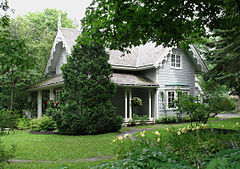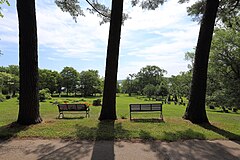| Sillery Heritage Site | |
|---|---|
| Native names French: Site patrimonial de Sillery French: Arrondissement historique de Sillery | |
 View of
Saint-Michel de Sillery Church | |
|
| |
| Type | Heritage site |
| Etymology | Noël Brûlart de Sillery |
| Location | Sillery, Quebec City, Quebec, Canada |
| Coordinates | 46°46′40″N 71°14′50″W / 46.77778°N 71.24722°W [1] [2] |
| Settled | 1637 [3] |
| Founder |
|
| Built for | |
| Original use | Saint-Joseph Mission of Sillery — Jesuit mission to members of the First Nations |
| Governing body |
|
| Official name | Site patrimonial de Sillery |
| Type | Declared Heritage Site |
| Designated | February 5, 1964 [4] [5] |
| Reference no. | 93522 |
The Sillery Heritage Site ( French: site patrimonial de Sillery) is an area containing historic residences and institutional properties located in the Sainte-Foy–Sillery–Cap-Rouge borough of Quebec City, Quebec, Canada. It was the first of 13 declared heritage sites ( French: sites patrimoniaux déclarés) of the Province of Quebec, and is among the four of which are located in Quebec City. [3] [6] [7] [8] Having been called the "cradle of the French Canadian nation," the heritage site includes approximately 350 buildings along 3.5 kilometres (2.175 miles) of the Saint Lawrence River shoreline. [5] [9] [10] The Sillery Heritage Site includes buildings constructed during every major period of Quebec's history, dating back to the time of New France.
Heritage designation

Heritage designation began as early as 1929, when the Jesuit House was assigned protective status. [11] The entire territory was officially recognized as a declared heritage site ( French: site patrimonial déclaré) by the Government of Quebec on February 5, 1964. [4] [5] [8] The heritage site was listed on Parks Canada's administered Canadian Register of Historic Places (CRHP; ( French: Répertoire canadien des lieux patrimoniaux), also known as Canada's Historic Places, on June 22, 2006. [5] The declared heritage site consists of five categorical groups of associated elements: 629 associated heritage immovable/real properties (including classified heritage immovable), nine associated movable heritage objects, 18 associated commemorative plaques, two associated groups ( Society of Jesus and Société des prêtres du Séminaire de Québec), and three associated persons ( General James Murray, Noël Brûlart de Sillery, and Jean-Antoine Panet). [4]
While recognizing the visionary action taken by Quebec's Ministry of Culture ( French: ministère de la Culture), in the 1960s, by conferring historic status upon the district to protect it from suburban developers, the National Trust for Canada ( French: Fiducie nationale du Canada), a national registered charity in Canada, placed the Sillery Historic District on its Top 10 Endangered Places list ( French: Palmarès des 10 sites les plus menacés), in the early 2010s, due to the approval of condominium developments which encroached upon historic religious properties in the district. [9] [12] In 2015, the City of Quebec announced that it would encourage any future developers to restore historic religious structures which were no longer owned by their former communities, in exchange for the allowance to undertake development on the surrounding lands. The city argued that some development was necessary to provide tax revenue in order to sustain the preservation of the historic district. [9] The Trust has subsequently removed the Sillery Historic District from its endangered list, and archived its status as a past listing, among other properties, spread across all of Canada's provinces and territories. [9]
Historic Properties
Among the district's properties are the early 18th century Jesuit House of Sillery ( French: maison des Jésuites-de-Sillery), [13] [14] 19th century workers' homes on Foulon Road ( French: chemin du Foulon (also known during this time period by the English language name Cove Road)) [15] and the Sillery coast (near Saint-Michel of Sillery Church ( French: église Saint-Michel-de-Sillery), villas built by wood barons in the 19th century, and institutional properties built at the turn of the 20th century. [16]
| Name | Address |
Coordinates (links to map & photo sources) |
Name (in French) |
|---|---|---|---|
| George William Usborne House (classified heritage immovable) [17] |  2316, chemin du Foulon |
46°46′04″N 71°15′28″W / 46.7678°N 71.25773°W | French: maison George-William-Usborne |
| Jesuit House of Sillery (classified heritage immovable) [18] |  2320, chemin du Foulon |
46°46′07″N 71°15′29″W / 46.768523°N 71.258053°W | French: maison des Jésuites-de-Sillery |
| Villa Bagatelle (also known as Spencer Cottage) [19] |  1563, chemin Saint-Louis |
46°47′18″N 71°14′48″W / 46.788278°N 71.24675°W | |
| Saint-Patrick Cemetery [20] |  1601, chemin Saint-Louis |
46°47′08″N 71°14′47″W / 46.78547°N 71.2465°W | French: cimetière Saint-Patrick |
| Mount Hermon Cemetery National Historic Site of Canada) [21] [22] |  1801, chemin Saint-Louis |
46°46′51″N 71°14′50″W / 46.78085°N 71.247197°W | French: cimetière Mount Hermon |
| Cataraqui Estate (classified heritage immovable) [23] |  2141, chemin Saint-Louis |
46°46′23″N 71°15′11″W / 46.77311°N 71.25319°W | French: domaine Cataraqui |
| Villa Beauvoir [24] |  2315, chemin Saint-Louis |
46°46′11″N 71°15′39″W / 46.769843°N 71.26086°W | |
| Kilmarnock Manor, residence of John MacNider | 46°46′04″N 71°15′52″W / 46.767678°N 71.264512°W | French: manoir Kilmarnock | |
| Bois-de-Coulonge Park (Spencer Wood / Government House) |  1215, Grande Allée Ouest |
46°47′20″N 71°14′24″W / 46.788889°N 71.24°W | French: parc du Bois-de-Coulonge |
| Saint-Michel de Sillery Church |  Views of the
Quebec Bridge and statue of the
Virgin Mary 1735, côte de Sillery |
46°46′28″N 71°14′39″W / 46.774334°N 71.244144°W | French: église Saint-Michel de Sillery |
- Spencer Grange, [25] 1328, avenue Duquet
- Canadian Montmartre and Sanctuary of the Sacred Heart ( French: Montmartre Canadien et Sanctuaire du Sacré-Cœur), 1669, chemin Saint-Louis
- Villa Benmore, [26] 2071, chemin Saint-Louis
- Villa Clermont, 2211, chemin Saint-Louis
- Bignell House ( French: maison Bignell), 1524, côte à Gignac
- Timmony House ( French: maison Timmony), 2014, rue Louis-H. Lafontaine
Bibliography
- "Visual Perspectives — Appendix XI.7 — Plan 1 of 1" (PDF) (in Canadian French). Planning and Conservation Commission, City of Quebec. Department of Legal Affairs, City of Quebec. October 2015.
- "List of Historic Buildings located on the Sillery Heritage Site — Appendix XI.7" (PDF) (in Canadian French). Planning and Conservation Commission, City of Quebec. Department of Legal Affairs, City of Quebec. October 2015.
- "2016 Map of the Heritage Site" (PDF). Department of Planning and Urban Development, Architecture and Heritage Division. Department of Legal Affairs, City of Quebec (in Canadian French). 2016.
- Plan de conservation — site patrimonial de Sillery (PDF) (in Canadian French). Ministère de la Culture et des Communications. July 2013. ISBN 978-2-550-65817-7.
See also
- List of historic places in Capitale-Nationale
- Sillery, Quebec City
- Mount Hermon Cemetery
- History of Quebec
References
- ^ "Site patrimonial de Sillery". Geographical Names Data Base. Natural Resources Canada. Retrieved July 26, 2022.
- ^ "Arrondissement historique de Sillery". Geographical Names Data Base. Natural Resources Canada. Retrieved July 26, 2022.
- ^ a b "À propos de la ville, Portrait, Géographie: Sainte-Foy–Sillery–Cap-Rouge" (in Canadian French). Ville de Québec. 2018. Archived from the original on 2018-10-07. Retrieved 2018-10-07.
- ^ a b c d Ministère de la Culture et des Communications (2013). "Site patrimonial de Sillery". Quebec Cultural Heritage Directory (in Canadian French). Government of Quebec. Archived from the original on September 24, 2015. Retrieved July 26, 2022.
- ^ a b c d Arrondissement historique de Sillery. Canadian Register of Historic Places. Retrieved 2018-10-03.
- ^ "Patrimoine culturel: Sites patrimoniaux déclarés (page 2 sur 2)". cpcq.gouv.qc.ca (in Canadian French). Conseil du Patrimoine Culturel du Québec. Retrieved July 26, 2022.
- ^ Ministère de la Culture et des Communications (July 3, 2020). "Secteurs d'intervention, Patrimoine, Protection et valorisation: Déclaration". www.mcc.gouv.qc.ca (in Canadian French). Retrieved July 26, 2022.
- ^ a b "Sites patrimoniaux déclarés par le gouvernement du Québec". Données Québec (in Canadian French). Government of Quebec. February 25, 2016.
- ^ a b c d "Issues & Campaigns, Top 10 Endangered Places, Explore Past Listings, Quebec: Sillery District". National Trust for Canada. Archived from the original on 2018-10-03. Retrieved 2018-10-03.
-
^
Commission de toponymie du Québec.
Fiche descriptive: Site patrimonial de Sillery.
{{ cite book}}:|work=ignored ( help) - ^ "Patrimoine culturel, Sites Patrimoniaux: Site patrimonial de Sillery" (in Canadian French). Conseil du patrimoine culturel du Québec. Archived from the original on 2018-10-07. Retrieved 2018-10-07.
- ^ "The future of the Sillery heritage site". Quebec AM, CBC Montreal. 2013-04-02. Retrieved 2018-10-03.
- ^ Légaré, Denyse; Labrecque, Paul (2008). Division de la culture, du loisir et de la vie communautaire de l'Arrondissement de Sainte-Foy—Sillery (ed.). Histoire de raconter: L'arrondissement historique de Sillery: Arrondissement de Sainte-Foy—Sillery [Storytelling — The Historic District of Sillery — Borough of Sainte-Foy—Sillery] (PDF). Itinéraires histoire et patrimoine (in Canadian French). Québec: Division de la culture, du loisir et de la vie communautaire de l'Arrondissement de Sainte-Foy—Sillery. ISBN 978-2-89552-058-0. Archived (PDF) from the original on 2018-10-11. Retrieved 2018-10-11.
- ^ "Maison des Jésuites de Sillery: Museums and historic sites: Heritage sites and attractions: Things to do". QuébecOriginal. Archived from the original on 2018-10-05. Retrieved 2018-10-05.
- ^ "Citoyens, Patrimoine, Toponymie, Fiche, Foulon — Chemin du" (in Canadian French). Ville de Québec. Archived from the original on 2018-10-05. Retrieved 2018-10-05.
- ^ Lapointe, Pierre Louis (2015-03-04). "Sillery (Qué)". The Canadian Encyclopedia. ISBN 978-0-77102-099-5. OCLC 904169186. OL 8533423W. Archived from the original on 2018-10-03. Retrieved 2018-10-03.
- ^ George William Usborne House. Canadian Register of Historic Places. Retrieved July 24, 2022.
- ^ Jesuit House of Sillery. Canadian Register of Historic Places. Retrieved July 26, 2022.
- ^ "Villa Bagatelle". www.musees.qc.ca. Société des musées du Québec. Retrieved July 24, 2022.
- ^ Ministère de la Culture et des Communications (2013). "Cimetière Saint-Patrick". Quebec Cultural Heritage Directory (in Canadian French). Government of Quebec. Retrieved July 24, 2022.
- ^ Mount Hermon Cemetery National Historic Site of Canada. Canadian Register of Historic Places. Retrieved July 24, 2022.
- ^ "Mount Hermon Cemetery National Historic Site of Canada". Directory of Federal Heritage Designations. Parks Canada. Retrieved July 24, 2022.
- ^ Cataraqui Estate. Canadian Register of Historic Places. Retrieved July 24, 2022.
- ^ Ministère de la Culture et des Communications (2013). "Villa Beauvoir". Quebec Cultural Heritage Directory (in Canadian French). Government of Quebec. Retrieved July 24, 2022.
- ^ Ministère de la Culture et des Communications (2013). "Spencer Grange". Quebec Cultural Heritage Directory (in Canadian French). Government of Quebec. Retrieved July 24, 2022.
- ^ Ministère de la Culture et des Communications (2013). "Villa Benmore". Quebec Cultural Heritage Directory (in Canadian French). Government of Quebec. Retrieved July 24, 2022.
External links
- Images of Sillery Heritage Site properties (in French) in the digital collections of Université Laval Library
- Historical Society of Sillery (in French)
- Discover the Neighborhoods of Quebec City: Sillery (in French)
- Lonergan, Joe. "The Sillery Irish". www.irishheritagequebec.net. Irish Heritage Quebec.
- An Authentic Plan of the River St. Laurence from Sillery, to the Fall of Montmorenci, with the Operations of the Siege of Quebec under the Command of Vice-Adml. Saunders & Major Genl. Wolfe down to the 5 Sepr. 1759 (Map). Massachusetts Historical Society.
- "Quarrying architectural stone, History, Sandstone: Sillery". Ministère de l’Énergie et des Ressources naturelles.

